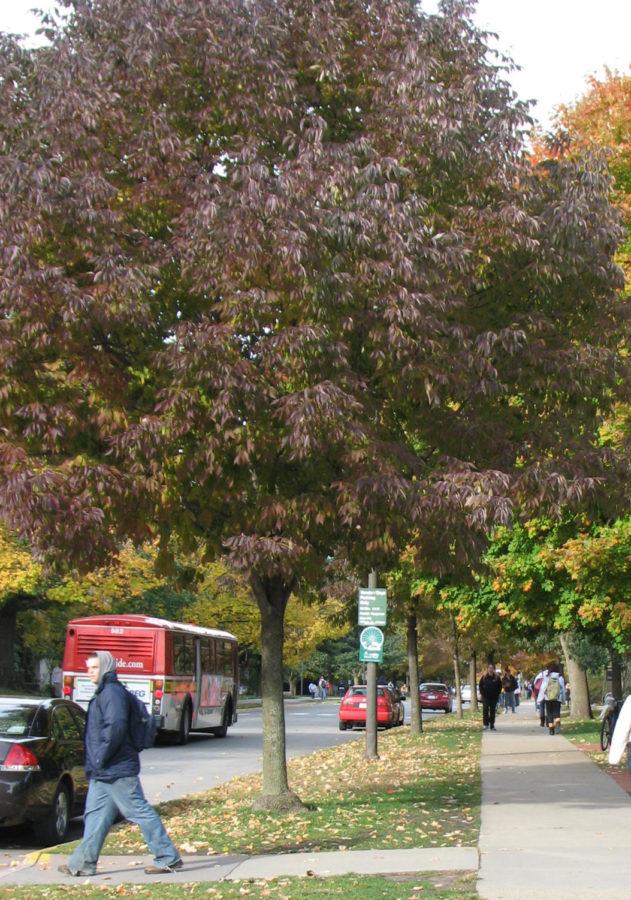Emerald Ash Borer threatens Ash trees in Iowa, ISU campus
The purple foliage is from the Autumn Purple Ash tree. The ash trees on campus are being removed as a precaution against the Emerald Ash Borer. The borer lays its eggs in ash trees, and the ash trees are eaten by the larvae after they hatch.
November 13, 2014
The emerald ash borer, an ash tree-attacking beetle, is invading the country.
“This insect is now found from Boulder, Colorado to New Hampshire and from Saint Paul, Minnesota to Georgia,” said Donald Lewis, Iowa State entomologist.
The beetle, believed to have traveled to the U.S. on boats from China in the 1990s, lays its eggs on the ash tree bark. When the larvae hatch, they bore into the tree and feed between the bark and the wood, the growing point of the tree. As the larvae eat, they begin to make tunnels in the tree, eventually killing it.
An emerald ash borer has already been spotted in Story County and in 12 other counties in Iowa. If actions are not taken to stop the beetles from spreading, the future that Lewis foresees may be here sooner than we think.
“One [larva] would not be a big problem,” Lewis said, “but in subsequent years and in multiple attacks by the species, the tree will become girdled, because the growing point of the tree has been killed by the feeding action of the larvae.”
According to Lewis, the whole process can take between three and five years to complete.
In the United States, the beetle was first discovered in Detroit, said Mark Shour, Iowa State Entomologist.
“There is a lot of trading that goes on in Detroit,” Shour said, “That era when [the beetle] was introduced, people were using firewood or moving nursery stock to different parts of the country. That’s how the biggest spread happened.”
It is not always easy to tell if a tree has been infected. The borer infects the tree from the top down, and according to Lewis, by the time the infection is noticeable it may be too late to save the tree.
Even the best methods of detecting the beetles only work 50 percent of the time, Shour said.
“If you were to walk into a room wearing a strong cologne, I could have picked it up quickly, but if it was a huge room and I was on the opposite side it takes a while for the odor to get there. It’s the same way with the beetle. Once it is found in the city, most of the time it has been there three to five years,” Shour said.
One way of stopping the spread of the beetle is by controlling the amount of ash trees that are planted.
“One of the unfortunate facts is that ash has been very popular. There are communities and golf courses that can be 70 percent or more ash tree,” Lewis said.
Iowa State has already started reducing the amount of ash trees they have on campus. For the past five years, ash trees have been replaced by trees that the borers are not attracted to.
“Five years ago, 20 percent of the trees on campus were ash varieties. Now we are down to eight percent,” said Rhonda Martin, landscape architect with facilities planning and management.
Martin said that they are not going to remove every ash tree on campus. They will save some for teaching purposes, but it’s not cost effective to save all of them.
“If you have a good, healthy tree that is important to you, no one can make you take it down. No one is insisting that you take it down,” Lewis said. “But if you have a tree that is struggling, it isn’t growing well, it’s in the wrong place, you can go ahead and take that tree out and replace it with something else.”
When a tree is removed on campus, at least one other tree is put in its place. Last year 300 ash trees were removed, while 417 other trees were planted, Martin said. If they had not removed the trees, Martin thinks that the problem would have been too hard to handle.
“Aesthetically we want to always have a beautiful campus; we’re an award winning campus,” Martin said. “We don’t want to lose 900 trees in two years. We are slowly removing and replacing so that you’re not going to notice the loss of those ash trees.”
It is believed that one reason the beetle population has spread so quickly is due to the movement of firewood across state boundaries, Lewis said. The beetles, unbeknownst to the transporters, hide in the piles of firewood, and when they arrive to a new location, they begin to infest healthy ash trees.
“It is probably inevitable that the spread continues,” Shour said. “Unfortunately people are not heeding our requests to not move firewood, and so the emerald ash borer is going to continue to move.”
Shour said they are trying to get the word out about the beetle, but not everyone listens.
“The reality is, as you drive through Ohio, Michigan and Indiana, you can see dead ash trees, and it’s likely to be our future as well, but we don’t know when,” Lewis said.







